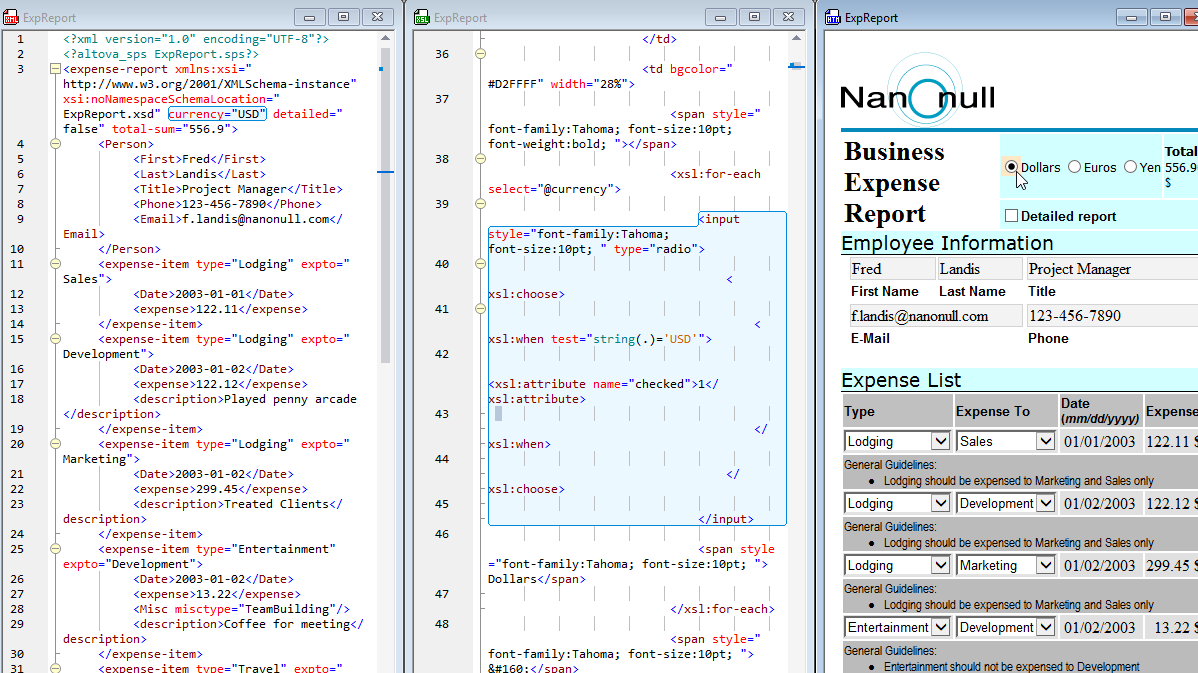
XSLT 3.0 Tools
Learn about XSLT 3.0 and Altova tools to edit, generate, and process XSLT 3.0
Learn about XSLT 3.0 and Altova tools to edit, generate, and process XSLT 3.0
eXtensible Stylesheet Language Transformations (XSLT) is part of the XSL standard from the W3C. XSLT uses XPath to navigate to and select XML nodes to transform a XML source file into something else. XSL is the language used to express a stylesheet, which defines the rules defining how to display and transform the data.
XSLT is used for transforming XML to XML (either according to a different data model, or by, for example, filtering some data), or into an HTML or text document. These transformations require an XSLT processor, which processes one or more XML documents with an XSLT stylesheet to produce an output document.
Considered a major upgrade from prior versions, XSLT 3.0 is the latest recommendation, released in June 2017. Version 3.0 introduced new features including streaming support, an extended set of functions, support for maps, arrays, and sequences, and more. XSLT 3.0 also includes support for transforming JSON documents.
XSLT 3.0 will work with both XPath 3.0 and 3.1. You can learn about XPath in our Quick Intro to XPath tutorial and complete online XPath training course.
Altova supports XSLT 3.0 – in addition to XSLT 1.0 and 2.0 – across the product line. Read on to learn about:
The XSLT editor in XMLSpy supports all the features of XSLT 3.0 with intelligent entry helpers, syntax coloring, code completion, and more. An interactive XPath builder and tester and built-in XSLT 3.0 transformation make it easy to develop and perfect your XSLT stylesheets.
The XSLT 3.0 editor includes XSLT back-mapping, which lets your select a section in your output document to immediately identify the source node and XSLT 3.0 instruction responsible for that output element. This is a huge time saver during debugging and also makes it easy to understand existing or inherited XSLT 3.0 code.
XMLSpy also includes a step-by-step XSLT debugger for more in-depth testing of your XSLT 3.0 stylesheets. The XSLT 3.0 debugger includes a three-panel interface that displays the XML document, the associated XSLT stylesheet, and the output document as it is being built in real-time. Below the three panels, Context and Callstack information windows include multiple tabs that supply all the necessary debugging information.
For ensuring your XSLT 3.0 stylesheets are coded for optimal performance, XMLSpy offers:
Developers can use the XSLT editor in XMLSpy for writing XSLT manually, or take advantage of visual, drag-and-drop XSLT 3.0 design using StyleVision for transforming XML to HTML.
Well suited for multi-channel publishing, StyleVision’s visual XSLT 3.0 design paradigm lets you develop sophisticated stylesheets quickly and easily, by dragging and dropping design elements and styling them with intelligent entry helpers and wizards.
Your single graphical design automatically produces the XSLT 3.0 and XSL:FO stylesheets to generate your output in HTML, RTF, PDF, and Word.
For generating XSLT 3.0 to convert XML to XML, MapForce is the best tool for the job. A graphical data mapping tool, MapForce makes it easy to drag and drop to convert XML between two or more data models. XSLT 3.0 is considered a major upgrade from previous versions of the transformation language and includes an extended set of functions: these are available in the MapForce Function Library for filtering and processing data during transformation.
Once you’ve defined the XML to XML mapping visually, MapForce automatically converts the data according to the target data model and generates an XSLT 3.0 stylesheet for recurrent transformations.
XMLSpy, MapForce, and StyleVision XSLT 3.0 tools are all included in the specially-priced Altova MissionKit. Get 7 XSLT tools for less than the price of 2!
In addition to XSLT 3.0 development tools, Altova offers RaptorXML Server, a lightning-fast XSLT 3.0 processor for high-volume transformations. By utilizing parallel computing, ultra-high-performance code optimizations, and a low memory footprint, RaptorXML Server delivers amazing processing speed. You can even take advantage its processing power inside XMLSpy when RaptorXML Server is installed on your network.



